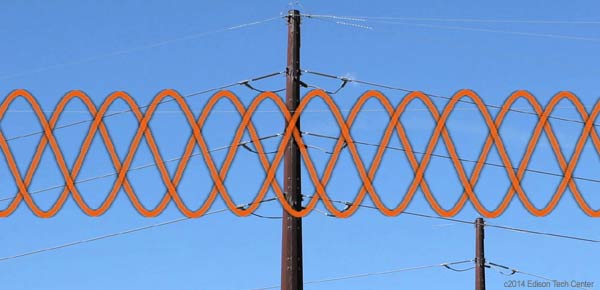Alternating Current Power Phases
What are phases?
If you were to look at household AC electric power in an oscilloscope, you'd see a sine wave:
You will see how the electric power repeats its 'cycle'. In household
power this happens 50 or 60 times in one second. If we have more than
one of these sine waves offset slightly we call each one a separate 'phase'.
In the simple model above this shows that electrical power increases to
a "+" value of 170 volts, and then drops back to zero and reverse polarity
to "-" 170 volts. The actual power we can get from this is 120 volts,
that is because we use the route mean squared (RMS) power measurement.
Learn how to calculate
RMS power here >
This perfect wave form is in theory of course, because the reality is that transients, harmonics, inductors, capacitive effect all do their job to distort the wave form. The wave form above is single phase and is the kind of power you have in a household. Power increases up and back to zero and so on, however this is not the best kind of power for long distance transmission. Engineers figured out that we can get more energy out of a generator if it is split into three phases. As you can see below the three phases create an almost constant stream of power (similar to DC power). Calculating AC power, especially three phase AC power requires advanced equations as it describes advanced physics.

Why is 3 phase power the system we use today?
Lionel Barthold, pioneer of utility systems describes why we use 3 phase. He investigated other systems at his company PTI and came to the conclusion that 3 phase was still the best way to transport AC power over short distances (HVDC is better for long distances).Generators:
Three phase generators have coils at 120 degrees from each other so it is quite natural for generators to produce three phase power. Before AC power generators needed a commutator to correct for the reversal of power and make direct current.
|
See our page on Generators
and Dynamos >
|
History:
The first alternating current was single phase power. Hippolyte
Pixii developed the first alternating current generator, but early
inventors had problems figuring out how to use the power it created because
power would reverse every cycle. Most inventors viewed AC as useless for
quite some time. In the 1870s Ottó Bláthy, Miksa Déri, and Károly
Zipernowsky pioneered the use of AC power
in Budapest, Hungary. They made the cycles so fast that lights appeared
to be continuously lit. They used transformers
which could alter voltage for long distance transmission. William
Stanley perfected a useful transformer when he lit Great Barrington
in 1886. He used a single phase Siemens generator.
Single phase AC power proved useful in 1886 with Stanley's demonstration,
however it had the major problem of not being able to power motors. AC
motors needed to be given a 'push' to get started. Without a good motor
AC could not compete with DC systems which already were in heavy
use in factories, trolleys and commercial
buildings.
Polyphase electric power was the solution to this problem. The origin of polyphase power is not clear as it had been written about in Europe as early as 1882. Nikola Tesla is given the most credit today for polyphase, however he was not the only proponent of polyphase systems at the time.
In 1888 the solution to the great problem with motors came about when AC motors when Galileo Ferraris's invented the polyphase induction motor. This 2 phase electric motor could start itself just like a DC motor. Tesla came up with his own version 8 months later and quickly cashed in on selling patents to Westinghouse. This started a few years of improvements. Westinghouse used power plants like the Ames at Telluride to test 2 phase power systems.
First 3 Phase Sytems:
We can credit C.S. Bradley with invention of the first three phase
generator in 1887 however it wasn't until 1891 when the world saw a fully
functional 3 phase power system. The Frankfurt
demonstration designed by Dobrovolsky solidified the usefulness of
AC power and ended the War of Currents.
Charles Steinmetz and Albert
Hull at the GE Research Lab experimented with monocyclic AC power
in 1908 and the 1930s but came to the same conclusion that 3 phase was
better.
Since that time various
companies have tried to experiment with other variations of polyphase
electric power, however it does not prove to be cost effective. The only
system which does threaten to dethrone the dominant 3 phase system is
HVDC. HVDC effectively delivers power long distance
with only one solid cable instead of 3. DC could also power homes and
save costs as the conductors would uses only a fraction of the copper.
Since raw materials continue to rise in price the idea of a DC world begins
to look more attractive. Continue reading about the
future in DC with this IEEE article >
Back to Electricity Basics
Related Topics:
Power Transmission

by M. Whelan
Photos/Graphics:
Edison Tech Center
Sources:
Interview with W.Kornrumpf. Edison Tech Center. 2013
Interview with Tom Blalock. Edison Tech Center. 2014
Interview with Lionel Barthold. Edison Tech Center. 2011
UNSW School of Physics, Sydney, Australia
Interview at San Miguel Power Assc. Edison Tech Center. 2014

